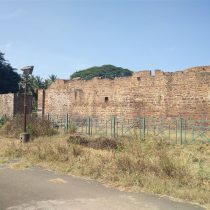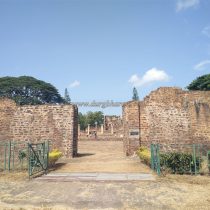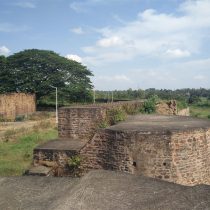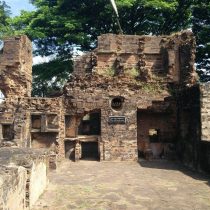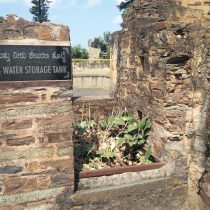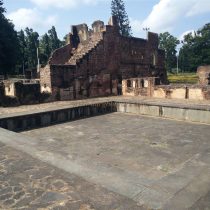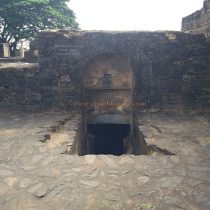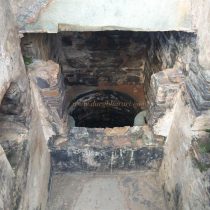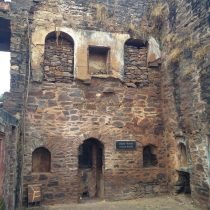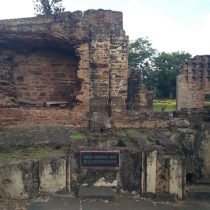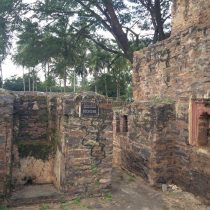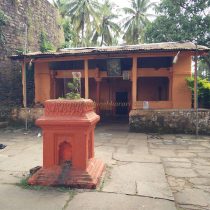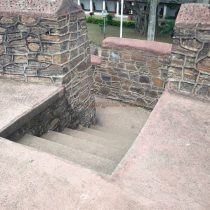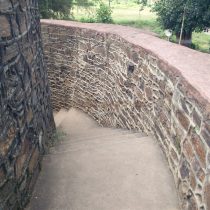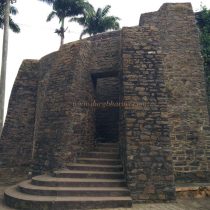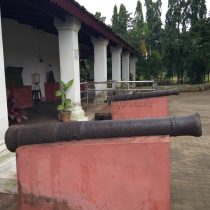KITTUR
TYPE : GROUND FORT
DISTRICT : BELGAON
HEIGHT : 0
GRADE : EASY
Belgaon and Maharashtra have been an inseparable relationship. Everyone remembers the name of Kittur village in Belgaon by the name of Queen Chenamma of Kittur. Rani Chenamma is revered in Karnataka as much as Rani Lakshmibai of Jhansi is revered in Maharashtra. In Maharashtra, everyone knows about the Queen of Jhansi and her bravery, but before that, very few people know about the revolutionary Chennamma, the first armed woman to take up arms against the British. This bloody struggle waged by a woman 33 years before the freedom struggle in 1857 is a golden page in Indian history but most people do not know Rani Chenamma except for the fort lovers who visit Belgaon and Kittur. Rani Chenamma's glorious history took place near the ground fort of Kittur.
...
To visit this fort you have to reach the city of Kittur. The distance from Belgaon to Kittur is 50 km and there are good transport facilities from Belgaon to Kittur. While visiting the fort, one can see a huge statue of Queen Chenamma on horseback in the central part of Kittur city. The fort of Kittur was built by Gowda Sardesai of the Desai family between 1660 and 1691. Signs of the use of stones in the vicinity of the fort can be seen while walking around it. The ramparts and barrage of the fort are still in good condition and moats have been dug on all four sides of the 28-acre fort. There are a total of 11 bastions in this rampart and one bastion is built in the center of the fort to keep an eye on the entire fort. The main gate of the fort is on the east side of the fort and there is a possibility of another small gate of the fort at this place. The entrance to the fort is by road but it is forbidden to take a vehicle to the fort. Inside the fort, there is a museum and a park and the entrance time is from 9 am to 6 pm. Upon entering the fort, one can see the moat outside the ramparts and the bastions at both ends. A small amount of soil has accumulated in the moat. Upon entering the fort, one path goes straight to the right and the other to the left. Both of these roads come together. You just have to turn left and start your fort round. At the beginning of the road, you can see the newly built Shiv temple near the original small temple. From here, after walking for 10 minutes along the ramparts, you come to the other side of the fort. There is a newly built temple of Goddess here and in front of the temple there is a Samadhi carved in stone. From here we take the main road to the left-hand side of the ramparts and we reach the eastern ramparts of the fort. The east-facing main gate of the fort is enclosed in two bastions. In front of this gate is the palace which is the main structure on the fort. The entire palace, with its medieval architecture, must be visited. The 330 x 220 feet wide palace is located at the northeastern end of the fort. There are guard posts on both sides as you enter through the east door of the palace. On the inside, there is a courtyard and on both sides, there are long quadrangle structures. There is a fountain on both sides of this structure. The remains of the palace show that it was once three story’s high. There are a total of three wells in the palace and two wells are easily visible but one of them is not. This should be the reserve of water in the palace. Apart from this, the living room, kitchen, dining room, warehouse, swimming pool, secret room, rest house, bedroom, temple, washroom, guest house, and water cisterns are all in good condition. In one part of the palace is the arsenal of the fort. After seeing the palace, we come to the bastion in the middle of the fort. There are steps inside to reach the top of the bastion. This bastion is known as Jhenda Buruj. From this bastion, the entire interior of the fort as well as the outer region can be seen. Adjacent to the bastion is the Hanuman Temple and in front of it is the Tulshi Vrindavan carved in the rock. When you come to the road in front of the temple, you come in front of the museum. Two cannons can be seen on the museum premises. This is where your fort round ends. It takes an hour to see the entire fort and another hour to see the museum. The ancient sculptures in the museum and rare memorials of women who went sati and sculptures of seven Goddess in the museum are worth visiting. In the museum at Kittur, there is an inscription dated 1188 by King Jayakeshi III of Goa, in which the result of the dispute over the land of the temple of Kittur is engraved. In 1534 Kittur village was a Jahagir to Yusuf Khan a militant chief of Asad khan ruled at Belgaon. At the end of the sixteenth century, with the army of Bijapurkar, two Lingai brothers named Malla Hireppa and Chikappa came to this area for business. Hireppa showed great bravery on the battlefield and got the title of Samsher-Jung-Bahadur and Sardeshmukhi of Hubli province. The fifth Desai from this family settled at Kittur. Sampagaon and Bidi were also under his control. At the end of the 17th century, Kitturkar Moody Mallappa Desai was the famous Desai in all of Karnataka. Moody Mallappa Desai agreed with Nawab Rauf Khan of Savnur. In the year 1746, Sadashivrao Bhau invaded this area with Mahadjipant Purandarya. He went to Tungabhadra and put terror in the minds of Nawab Savnoorkar and Desai of this area. He conquered 35 provinces like Kittur, Gokak, Parasgad, and Yadavd. In the year 1746, the Nawab of Savnur had to hand over Kittur along with other provinces to the Marathas. From 1756 onwards, Parasgad, Sampagaon, and Bidi provinces were handed down from generations in the Desai family. In 1778, he captured Gokak. In 1778, Haider handed over the land to Kitturkar on the condition of paying a ransom and other gifts. But in the year 1779, Parashurambhau Patwardhan captured Gokak and imprisoned Desai. In the year 1785, Tipu captured Kittur, Nargund, Ramdurg, etc., and kept a detachment of his army at Kittur. To put an end to Tipu's rule, Nana Phadnis met the Nizam at Udgir and the two decided to invade Tipu together. The Marathas and the Nizams came together and the Peshwas, with 25,000 troops under Ganeshpant Behere and Tukoji Holkar, defeated Tipu's chief Burhanuddin at Kittur, but the fort of Kittur remained under Tipu's control. In the battle of Savner in 1787, Tipu made a treaty with the Marathas, according to the treaty 48 lakh rupees and forts of Gajendragad, Badami, Nargund, and Kittur was decided to return to the Marathas, but as soon as the Maratha army retreated, Tipu recaptured the fort of Kittur. When Kittur was under Tipu's control (1785-1787), Tipu's general Badr-ul-Zaman was in charge of the Desais. According to the treaty of Srirangapatna in 1792, the fort and territory of Kittur came back to the Marathas. The Peshwas gave it to Parashurambhau Patwardhan. Parshurambhau appointed a case officer at Kittur and transferred this area to the Dharwad sub-division and appointed Desai as a tax collector of Kittur. Haider and Tipu were enemies of the Marathas. Desai of kittur always make a settlement with them & always harassed the Marathas so Peshwas made the above plan. In the year 1800, Dhondya Vagh raided Kittur from the back and Maratha general Dhondopant Gokhale was killed. In the year 1791, the same Dhondopant had defeated the Dhondya Wagha. Kittur province was under the control of Dhondya Wagh for a few months. In 1802, under the control of Kitturkar Mallasarja Desai (1782-1816), Kittur had an annual income of Rs. 4 lakhs and he used to pay Rs. 60,000 as an annual ransom to the Peshwas. In the same year, General Wellesley was on his way from Srirampatnam to Pune to help Bajirao Peshwa, who had helped him in the past. In the year 1809 Peshwa called, these Desai to Pune. In the treaty held at that time, his rule remained with him and he was given the title of 'Prataprao'. In return, Desai decided to pay a ransom of one lakh five thousand rupees a year to the Peshwas. Desai built a fort called Pratapgad near Nandgad to commemorate the title of Prataprao. In the Maratha-British war of Belgaon in 1818, Kitturkar Desai helped the British against the Peshwas by providing them with ammunition. Twelfth Desai Shivalingarudra Sarja died childless in 1824. Rani Chennamma adopted Shivalingappa and gave him the throne, but Thackeray, the Dharwad Collector of the British East India Company, did not accept the adoption and confiscated Kittur's Deshmukhi. Upon hearing the news that her Kittur Sansthan would be disbanded, Rani Chennamma tried her best to get her adoption statement approved by the British. Rani Chennamma revolted against the British for the adoption. This uprising is known as the Battle of Kittur. To help Queen Chennamma militarily, Buvasaheb Maharaj of Kolhapur marched towards Kittur with a thousand cavalry and five thousand infantry. But when the Dharwad agent came to know about this, he informed the Governor of Mumbai. Later, on the order of the governor, the political agent sent a warning letter to Buwasaheb. After receiving this letter, Buwasaheb returned to Kolhapur with his army. In this war, Rani Chennamma herself fought the British on horseback. Thackeray was killed in this battle but on December 2, 1824, Kittur was conquered by the British. The British seized Rs 16 lakh in cash and Rs 4 lakh in jewelry, horses, camels, elephants, 36 cannons, guns, swords, and ammunition in the fort. Rani Chennamma was imprisoned at the fort of Bailhongal. The brave queen died in British captivity on 21 February 1829 and the British annexed Kittur Sansthan. Millions of tributes to this heroism of the revolutionary queen Chennamma.
© Suresh Nimbalkar

